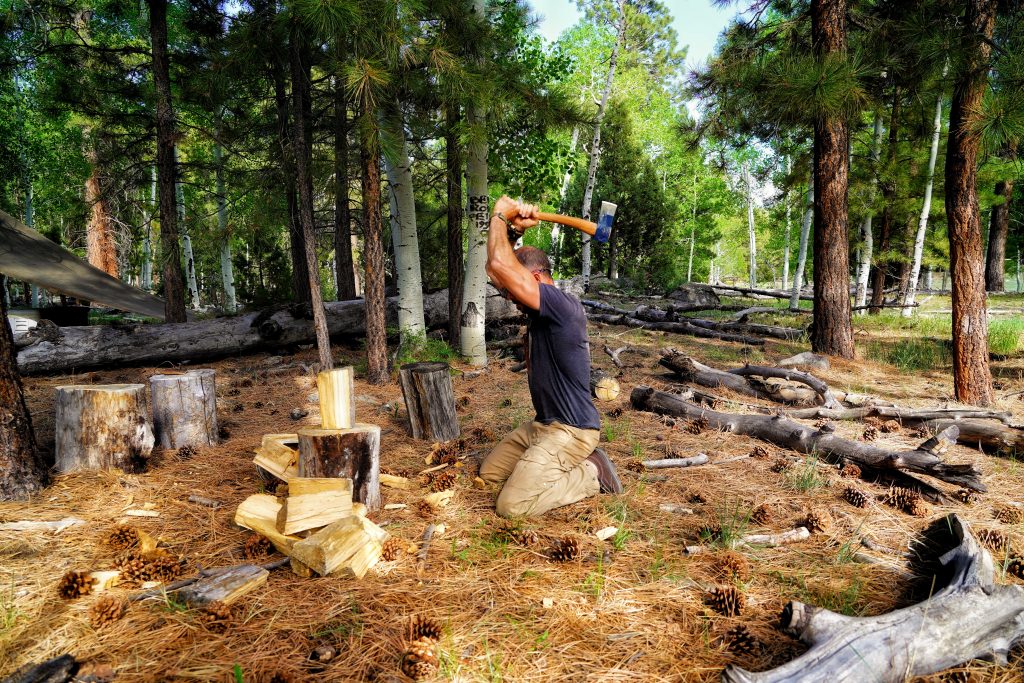
My grandfather was brilliant at sharpening, and something he told me three decades ago still goes through my head every time I pick up an edged tool: “Son, if you’re not a little scared of it, it’s not sharp enough.” It took me a while to understand what he meant, but there’s a scar across my thumb that reminds me if I ever forget.
The axe is an elegantly simple tool, yet its graceful lines betray how astonishingly efficient it is at its job. This thought should be front of mind every time we pick one up, and is precisely what my grandfather was talking about: keen respect for a keen edge.
Whether it’s a cut from a slip while sharpening or a life-threatening arterial bleed, knowing what to do, having a plan to do it, and carrying what’s needed to execute that plan are essential pieces of every woodcutter’s kit. That’s true whether you’re in the backyard or the backcountry.
If you plan to use an axe in the backcountry, consider taking a wilderness medicine course. Even if you only camp and travel solo, the content you’re exposed to through these courses can create a heightened frame of mind for mitigating risk in even the most austere environments. You’ll also learn the basic skills and importance of creating and maintaining a first aid kit you’re familiar with and know how to use. As a result of my certification, I built a first aid kit that goes wherever my axes go.
Such courses emphasize the crucial components of rapid and reliable communication. If you use an axe in areas beyond cell service, consider renting or investing in a satellite communicator. Help might only be an hour away with quick initial communication, but that becomes a critically long time for someone suffering from an arterial bleed. Add the compounding elements of winter (i.e. shorter days, harsher weather, slower and more difficult travel over snow, keeping a patient warm, etc.) and the need for rapid and reliable communication goes up exponentially. In short, every second counts, so have a plan to not waste any of them.

Know your limitations.
Knowing your limitations as well as those of your axe is another key component of the woodcutter’s kit. The axe might not be the best tool for some jobs, depending on your skill set and environment. While felling trees with an axe sounds nostalgic, it can be incredibly dangerous and is not advised for the untrained. Learn safe techniques for limbing and bucking with both an axe and a saw. Develop a skillset for splitting firewood on the ground (i.e. without a flat chopping block).
I generally teach that the shorter the axe is, the “shorter” your legs should be. That is, it’s often safer to use hatchets and small camp axes while kneeling. This is because the arc of a missed blow with a hatchet while standing can easily land in your shin or thigh. A miss while on your knees will generally put the bit in the dirt.

Stay focused, stay aware.
While it may sound odd, stay focused on using the axe when using an axe. While you’re swinging a hunk of razor sharp steel around on the end of a stick is no time to become distracted. Stay aware of the bubble around you at all times and be sure it’s free of anything or anyone that can interrupt your swing. Also be mindful of things like loose footing on snowy or wet ground, cold hands, swarming bugs, fatigue, fading light, loose clothing, etc.
On a final note, be sure to match the right axe to the right job. You may not have the benefit of more than one axe or hatchet to choose from, but be sure you’re not requiring a small hatchet to do something it can’t do safely, or toting a full sized felling axe just to split kindling.
Until next time, stay safe out there and keep that axe and that focus sharp!
Disclaimer: For Educational and Informational Purposes Only. Although care has been taken in preparing this information, Hults Bruk and Curt Isaacson are not responsible for any errors or omissions, and neither party accepts liability for any loss or damage.
